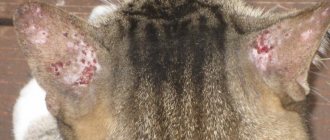Subcutaneous mites in cats (demodex): what is it?
In domestic animals, askariasis is caused by different types of parasites. But the most commonly diagnosed is demodicosis - a chronic disease caused by Demodex cati and Demodex gatoi.
The arthropod is localized in the hair follicle, sweat (epocrine) and salivary glands. Larvae hatch from oocytes laid by females on days 4-6. After 7-10 days, individuals ready for reproduction grow. Pathogenic microorganisms live in colonies, forming painful nodules on the body of predators. Enlarged colonies cause atrophy of the sebaceous glands and disruption of skin functions.
There are two types of demodicosis: generalized and localized. The latter is characterized by damage to certain areas of the body: ears, eyes, chin and neck. Generalized spreads throughout the skin. This form is common in purebred Siamese and Burmese breeds.
Symptoms of demodicosis
Localization of demodex is most often noted in the abdomen, withers, ears, muzzle and tail. The parasite can multiply and live on a cat for quite a long time, while the disease itself will not manifest itself. When an animal's immunity decreases, the following symptoms are observed:
- deterioration in the appearance of fur;
- the appearance of peeling in the eye area;
- damage to skin pigmentation;
- detection of dandruff throughout the fur;
- hair loss in some areas;
- acne formation;
- due to itching and discomfort, the pet itches all the time, scratching the damaged skin until it bleeds;
- a hardened crust up to 2–12 mm high forms in the infected area;
- ichor is released on the growth;
- bald areas become covered with small ulcers and acquire a pearlescent hue.
Such symptoms appear due to the constant movement of the parasite across the skin, which leaves its waste products on it. To see demodex, the balding areas need to be gathered into a fold. The found parasite and the pet itself should be immediately taken to a veterinary hospital for diagnosis and appropriate therapy.
Also read the article about eye diseases in cats so as not to confuse their symptoms with demodicosis.
Causes of subcutaneous mites in cats
Ticks are part of animal life. Some live in hair follicles for years, feeding on dead epithelial cells. The predator's immune system controls the parasite population. If the pet is weakened, the body's protective functions reduce the ability to regulate the number of arachnids. Arthropods multiply rapidly, attacking healthy cells.
Factors influencing weakened immunity:
- helminthic infestations;
- hereditary or chronic diseases;
- unbalanced diet, lack of vitamins and minerals;
- improper maintenance and care (dirty litter);
- rare or lack of water procedures using antiparasitic agents.
Be sure to read:
When to worm kittens for the first time: for what, at what age is it better, how to do it correctly, the best drugs
Stress also reduces the body's protective functions.
Useful tips
- Never wash your cat with antiparasitic drugs intended for dogs! These products have a completely different composition, and it is more toxic. Ingredients that are not dangerous for dogs are very dangerous for cats, even with fatal consequences.
- If you have to deal with an animal with demodicosis, do not forget to wear a cape and gloves. No, demodexes are not dangerous for humans, but you can accidentally bring the parasite into your apartment, thereby infecting your pet.
- If your pet has already been infected with a subcutaneous tick and has successfully recovered, preventive measures should still be taken. Moreover, after an illness, the cat will feel unwell for some time. This is explained by the fact that the drugs used to treat the skin are absorbed into the blood and are not eliminated for three months.
- With the permission of the veterinarian, periodically carry out preventive measures using an antihistamine, which will prevent infection, eliminate possible itching, relieve discomfort and reduce allergic reactions. The drug will be prescribed by a specialist.
- Remember that parasites, including Demodex, do not survive in a dry environment. And if you find an ulcer on a cat’s skin, you should immediately dry it (for example, with hydrogen peroxide, it is safe for animals), and then immediately show your pet to a veterinarian.
- Try to regularly examine your pet for affected areas, especially if the cat begins to itch frequently. Using a magnifying glass, carefully look for even the slightest signs of subcutaneous mites: convex tubercles, bald spots, pustules, redness, dandruff, ichor discharge from wounds, sores and bald patches.
- At the slightest suspicious signs such as lethargy, temperature, refusal of water and food, aggression, changes in mucous membranes, etc. You must immediately take your pet to the doctor. It is possible that the animal became a victim of a subcutaneous tick.
- Whatever medications you use, for prevention or treatment, always read the instructions carefully so as not to inadvertently harm your pet. Study the composition, indications, use, purpose, dosage, contraindications and expiration date.
You can also contact our site's staff veterinarian, who will respond to them as soon as possible in the comment box below.
Subcutaneous mites in cats: routes of infection
Infection of a healthy predator occurs through direct or indirect contact with a sick one. Parasites are spread by using a shared brush to comb out wool and bedding. Microorganisms enter the apartment with clothing when a person comes into contact with an animal affected by arthropods.
Routes of infection:
- direct contact with a sick predator;
- contact with the fur of a predator affected by demodicosis;
- intrauterine.
If a breeder has several pets, therapeutic measures are applied to all of them without exception.
Diagnostics
The process of diagnosing subcutaneous mites in cats is quite complex; it can only be carried out by specialists in laboratory conditions.
Confirmation of the diagnosis is carried out as follows:
- and the contents of the resulting tubercles is performed to make a diagnosis
- Skin particles for analysis are taken by squeezing it on both sides so that the parasites can be squeezed out. Often, several subcutaneous mites can also be found in completely healthy pets. However, if such an amount was recorded in the presence of accompanying symptoms, then a repeat test will be required. Identified parasites are often placed in an artificially created habitat for them in order to be able to observe the process of their reproduction and the development of the created colony.
- The pet's waste products, blood are analyzed, as well as a study of its condition using ultrasound methods. Such diagnostics are necessary to detect possible complications that may be caused by the activity of subcutaneous mites or the accidental entry of secondary microflora into the pet’s body.
Animal risk group
Parasitic arachnids affect all predators, regardless of breed, sex, or age. A healthy pet with a strong immune system is not in danger. Under such conditions, the animal and arthropods are in an antagonistic relationship, where the cat’s body slows down the growth of parasitic microorganisms.
The following groups are susceptible to demodicosis:
- young individuals, especially those separated from their mother early;
- affected by leukemia and immunodeficiency viruses;
- with diagnosed immunosuppressive diseases (diabetes mellitus, toxoplasmosis);
- animals in the postoperative period;
- young offspring during the period of change of milk teeth to molars (4-6 months);
- exhausted after fasting;
- patients with rickets.
Stress caused by moving and frequent visits to the groomer negatively affects the health of the pet. The risk of ascariasis increases.
Causes of infection
A cat of any breed and any age can get demodicosis. However, a microscopic mite, having entered the animal’s body, may not manifest itself for a long time (until the right moment comes), and the cat becomes a carrier of the parasite. When the cat is in normal condition, the tick “sleeps”, but when immunity decreases, demodicosis worsens, and the tick begins to secrete waste products that poison the cat’s body.
It is known that Burmese and Siamese cats are particularly susceptible to mange, but other animals may also be at risk:
- cats that have recently had surgery;
- pets who have recently suffered from an infectious disease;
- animals infected with worms or fleas;
- cats and kittens in a state of severe stress;
- animals that are not eating properly (for example, if the cat receives too little protein during natural feeding);
- cats that have recently been treated with antibiotics or hormonal drugs.
The main reason for the development of the disease is considered to be a decrease in the cat’s immunity, as a result of which the tick takes a pathogenic form and begins to actively multiply in the epidermis of the animal. Very often the disease is registered in small kittens after weaning them from their mother.
Subcutaneous mite symptoms in cats
The clinical picture is specific. An increased number of parasitic microorganisms causes itching. First, there is increased hair loss, as if molting. Patchy bald patches of regular oval shape appear. In areas of alopecia, the skin is intensely red and covered with ulcers. Secondary staphylococcal infectious pathologies are added. The area around the eyes, under the neck, and front paws is most often affected.
Summary symptoms:
- hair loss;
- “demodectic glasses” – lack of hair around the eyes;
- inflammation, redness of the skin, swelling;
- skin pustules, ulcers;
- unkemptness, foul odor;
- the bites cause itching, the predator scratches the ear area until it bleeds;
- lack of appetite;
- weight loss.
In the generalized form, sepsis develops. Sometimes pets recover without treatment, but only with a localized form.
Symptoms
Demodectic mange is dangerous, first of all, because it develops gradually, so it is not always possible to immediately notice the presence of a subcutaneous mite on an animal’s body. The owner may not immediately understand that her pet is sick with demodicosis, and if there is any suspicion of this disease, it is necessary to show the pet to a doctor as soon as possible. The fact is that the longer Demodex parasitizes, the more dangerous it is in terms of reducing the animal’s immunity. What signs indicate the presence of a subcutaneous mite?
- The coat loses its original healthy appearance;
- Dandruff appears around the eye, the skin turns red and peels;
- Hair loss is observed in some places, sometimes in tufts;
- The pet is tormented by itching, he often scratches certain parts of the body with his teeth;
- Hard and slightly convex growths appear on the animal’s body;
- The affected areas become bald, and pustules form on them;
- The wounds that appear on the cat’s body bleed with ichor.
In order to accurately diagnose demodicosis, it is necessary to carry out several tests. To do this, a scraping is taken from the animals, which is carefully examined under a microscope. And only after diagnosis, depending on the type of disease, the doctor prescribes treatment.
What does a subcutaneous mite look like in cats?
Demodexes are very small and can only be seen under a microscope. They are worm-shaped. An adult male is 182 microns long, 20 microns wide, a female is 220 microns long, about 30 microns wide. Arachnids are gray in color.
Be sure to read:
How to deworm a cat: when to do it, how often, the best drugs and folk remedies
The cephalothorax and abdomen are fused. The prosoma has 4 pairs of short legs, each of which consists of three segments ending in claws. The proboscis is well developed.
Types of diseases caused by ticks
The mite infects the skin by burrowing into the surface of the epithelium. The result is inflammation and severe itching. After scratching, ulcers and layers of skin flora form on the affected areas. Each type of parasite is characterized by the localization of its activity, complications and degree of danger for cats. Ticks can cause a variety of infectious diseases in pets. Most often they appear:
- Demodectic mange is the most common parasitic disease, provoked by waste products of ticks. Due to the resulting inflammatory processes, the fur and skin of animals are affected.
- Ear scabies is one of the most common types of demodicosis. It develops when mites enter the cat's ear. Ears are a rich source of food for pathogens. In addition to dead epidermis, earwax, dandruff and other formations accumulate in the cavity. In the ears affected by the disease, black accumulations in the form of dirt can be seen. These are waste products of ticks that have settled there and the remains of dried blood, emitting an unpleasant smell of rotting.
- Hemobartonellosis is a disease that is caused by ixodid tick bites, but can sometimes occur due to allergic reactions and suppuration from the activity of parasites. This infection is extremely contagious. The main manifestation of the pathology is anemia.
The tick penetrates the epithelium through a bite. The bite site on the pet's skin is easily detected, as it appears in a bright red color. After infection, the cat's lymph nodes become enlarged. This indicates the development of an inflammatory process in the body.
The parasite that has penetrated the skin feeds on its cells and actively reproduces. Decomposition products negatively affect the epidermis, weakening its protective functions. As a result, it is easily susceptible to pustular lesions and allergies.
Treatment of subcutaneous mites in cats
At the first symptoms, your furry friend should be taken to the veterinary clinic. Only a doctor can make an accurate diagnosis.
Local therapy of uncomplicated forms:
- To eliminate exudate, dead epithelium, and dandruff, your furry friend is bathed with shampoos containing antiseptics (benzoyl peroxide).
- The area around the wounds is treated with Mitaban solution. For localized demodicosis, a 0.25% solution is used, for generalized demodicosis without complications - 0.5%. In generalized forms with pyodemodecosis and staphylocosis, 1% working concentration of the drug is used for treatment.
- The use of Advocate drops is indicated for therapeutic and preventive purposes. Using a pipette, the drug is applied to dry, intact skin in places inaccessible for licking (between the shoulder blades) at the rate of 0.1 ml per kg.
- Use topical medications containing pyrethrin or amitraz (Advantix, Prak-tik, Advantage). The regimen and dosage are calculated in accordance with the recommendations in the instructions or as prescribed by the veterinarian.
- To relieve inflammation, ointments (sulfur, Avexectin, Saproderm) and gels (Demox, Amidel, Ivermit) are prescribed.
During therapy at home, it is important to follow the dosage prescribed by your doctor. Exceeding concentrations can harm the health of your four-legged friend.
Medicines and injections
When an animal is initially infected, it is quite difficult to decide on the choice of drugs to eliminate parasites. Each type of disease requires its own medications to treat, so it is best to seek help from a veterinarian.
Localized demodicosis
In this case, damage to small areas of the skin is observed. Only a veterinarian selects the drug and can prescribe ointments, shampoos and sprays. Basically, the doctor prescribes the following medications:
- Sulfur or aversectin ointments;
- Unoiled;
- Tsidem;
- Liniment Demos;
- Amit;
- Ivermek-gel.
Do not forget that the products are applied to skin cleansed of hair.
The pet also needs medications to boost its immunity. Usually prescribed:
- Gamavit;
- Immunoparasite;
- Gala Vet;
- Maxidin.
Generalized demodicosis
This type of disease is more difficult to treat because all of the pet’s skin is damaged. Do not despair even if your animal develops ulcers and severe irritation - the disease can be overcome.
To better absorb the medication for external use, the cat should be trimmed and bathed with a special shampoo (Doctor VIC). Then the skin is soaked in sea buckthorn oil, and after it dries, the prescribed medication is treated.
If the disease is severe, injection solutions are prescribed:
- Cydectin – single dose – 0.4 ml;
- Dectomax - the dose is determined by the veterinarian taking into account the pet’s body weight.
The development of complications indicates the addition of a secondary infection. In such a situation, a course of antibiotics is prescribed:
- Betamox;
- Amosina;
- Amoxicillin;
- Kanamycin;
- Baytrila.
It is important for an animal to eat properly. You should include foods rich in vitamins and minerals in your diet.
Drugs and medications
Localized forms with complications and generalized forms are treated comprehensively. Medicines are selected individually, taking into account concomitant diseases and the condition of the predator.
In case of infection with D. cati and D. gatoi, use the following treatment regimen:
- Amitraz 0.25%. The oil solution is applied to the affected areas once a day every 3 days. Course 4-6 weeks.
- Invec spray is applied to the affected areas. Treat 2-4 times with an interval of 3-5 days.
- Doramectin orally once a day at a dosage of 40-60 mg per kg of body weight. Therapy is carried out for no more than a month.
- Antiparasitic drugs for parenteral administration (s.c.): Dectomax, Baymek, Cydectin.
- Antibacterial drugs Betamox (active ingredient amoxicillin), Kanamycin (amikacin), Ciprovet drops (ciprofloxacin).
Be sure to read:
Are worms transmitted from cats to humans: how, are they dangerous, what diseases do they cause, how to avoid getting infected
Since the fundamental ethological factor is weakened immunity, biogenic stimulants are prescribed: Gamavit, Baksin.
Treatment of localized form
Before selecting treatment for demodicosis in cats, it is necessary to determine the form of the ongoing disease. When a specific area is affected, most often the head or neck, a localized scabies mite is identified. Treatment of this form of disease is based on the following rules:
- Bathing your pet using special products.
- Treatment of affected areas with medicinal compounds.
- Cleaning your pet's skin from scabs.
- Immunotherapy.
For bathing and cleaning the skin, you can use special shampoos with chlorhexidine. This component in the form of a solution is excellent for treating affected areas of the epidermis. You can also use regular peroxide. Using these products you can effectively cleanse the skin of scabs.
The localized form responds well to treatment and has a favorable prognosis.
Folk remedies
In parallel with traditional ones, alternative methods of therapy are used. folk recipes against askariasis:
- Infusion of leather mackerel. 1 tablespoon of dry herb is poured into about 5 liters of boiling water and set aside until it cools completely. The strained solution is diluted with 0.5 liters of water and the pet is bathed. The plant has a bactericidal effect and promotes rapid healing of wounds.
- Wounds are treated with calendula tincture. To avoid side effects, it is better to buy the product at a pharmacy and use it according to the instructions.
- Treatment of wounds with concentrated chamomile infusion. To prepare it, 100 dry plants are poured with boiling water. The cooled infusion is filtered.
It is forbidden to treat leather with kerosene. The substance causes severe intoxication.
Prevention of demodicosis in cats
The basis of prevention is strengthening the immune system and preventing diseases that contribute to the development of askariasis:
- Organization of adequate nutrition and proper care.
- Weekly treatment of the pet's bedding, tray, and bowls with disinfectants.
- Regular prevention of ectoparasites (fleas, lice eaters) and endoparasites (tapeworms, nematodes) using tablets and sprays.
- Wearing Multi-X anti-parasitic collars.
- It is recommended to sterilize a female who has suffered a generalized form.
If the animal has received therapy for demodicosis, the pet is taken to the clinic every 6 months for the first 3 years to monitor relapse.
Preventive measures
To minimize or completely eliminate the risk of infecting a domestic cat with scabies mites, it is necessary to follow some measures to prevent demodicosis.
First of all, you need to create a complete, balanced menu for feeding your four-legged friend. A healthy diet strengthens the immune system, which already reduces the likelihood of parasitic infection.
It is also important to regularly treat the wool with special products against fleas and other microscopic individuals that contribute to the development of unpleasant skin diseases.
In the autumn-spring period, it is advisable to strengthen the cat’s immunity with vitamin and mineral complexes. These same drugs are especially relevant for weakened, often sick animals.
They are selected on an individual basis, so it is not recommended to prescribe vitamin therapy to your cat on your own. It is better to consult an experienced veterinarian and purchase effective products for their intended purpose.
Do not allow your cat to come into close contact with street representatives whose condition causes you some suspicion. And remember, any disease is easier to prevent than to cure, so do everything possible to prevent your furry pet from becoming infected with demodicosis.











